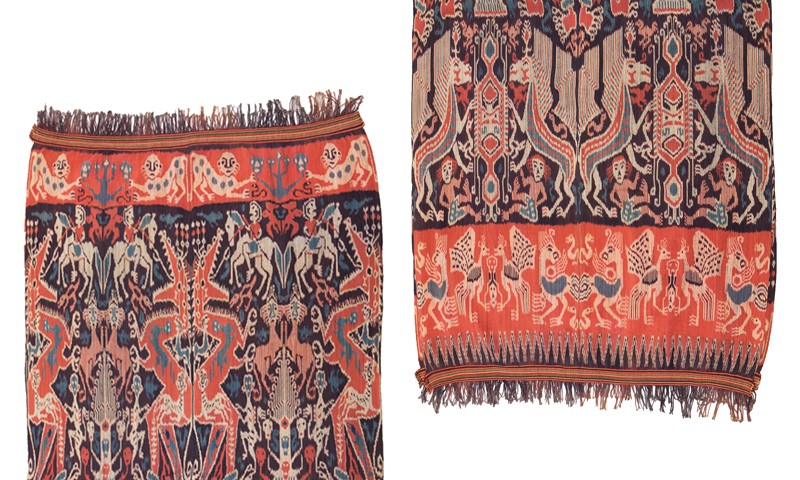 |
Shoulder Cloth (Hinggi), late 20th Century
Sumba culture; Sumba Island, East Nusa Tenggara Province, Lesser Sunda Islands, Indonesia
Cotton; 96 × 112 in.
2016.15.45
Anonymous Gift |
Syncretic Dyeing
Art has always been a chorus of different groups reacting to, influencing, inspiring and drawing upon one another’s creations. On the small East Indonesian island of Sumba, this interplay fomented a hybrid iconography pulled from local, European and Asian motifs. The canvases for these hybrid designs are hinggi, a variety of ikat textile which would have been worn, as opposed to many of the other purely decorative textiles from Indonesia. In this post we look closely at four relatively contemporary examples of hinggi, taking note of their usage, creation, and design.
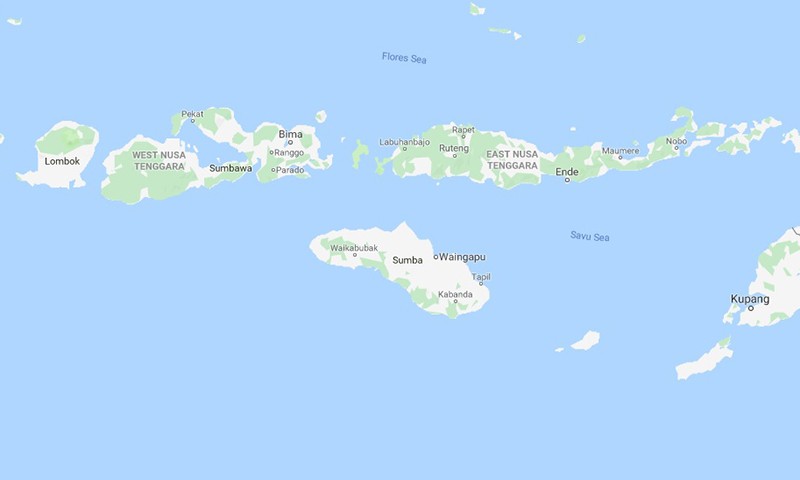 |
| The Indonesian island of Sumba; Google Maps |
Man Mantles
Hinggi are rectangular cloths, generally 8 to 10 feet in their longest dimension, that were traditionally worn as male-exclusive formal attire at wedding and burial ceremonies and at other feasts, festivals and ceremonial events. Rather than being worn as just one textile, near-identical hinggi are worn in pairs as waist and shoulder cloths. One of the constants throughout the loosely associated Indonesian islands is the importance of textiles as an essential facet of what separates humans from animals. Hinggi fit the bill for the utilitarian function of clothing, but they also convey a certain amount of status and prestige. Designs could only be worn by individuals of the corresponding social ranking and age. Individual colors and motifs held particular meanings and could only be worn by certain individuals. Hinggi also double as funerary shrouds. There are cases of princes being mummified in their hinggi.
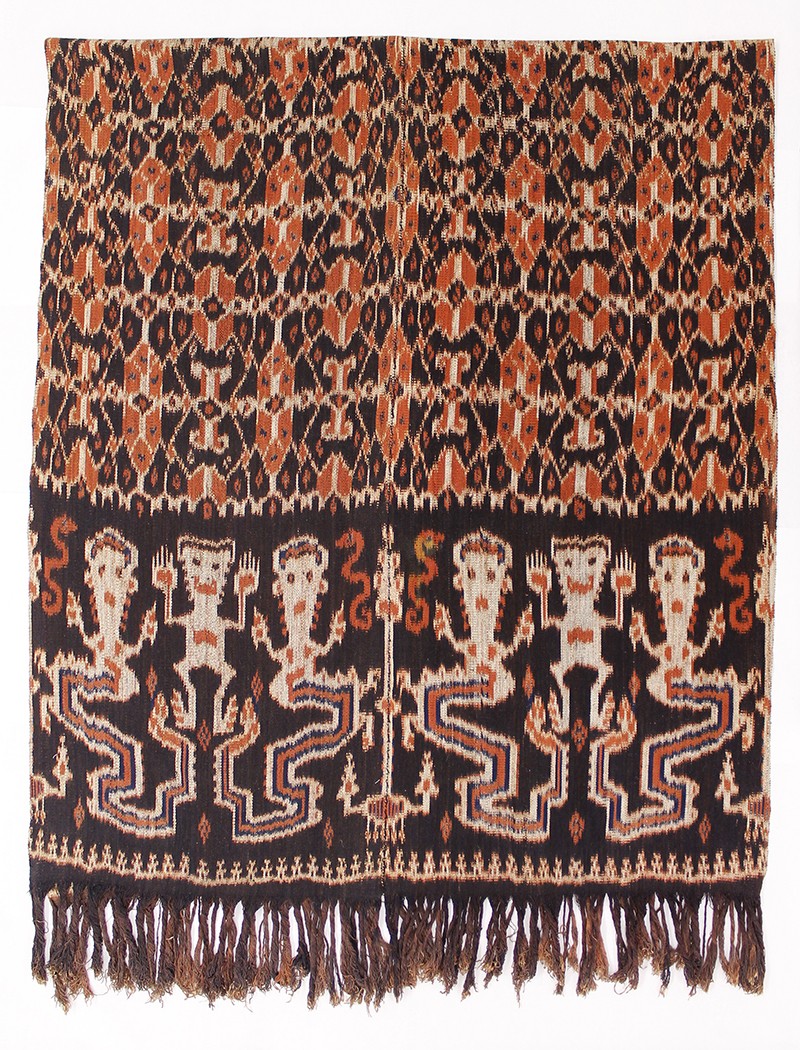 |
Shoulder Cloth (Hinggi), late 20th Century
Sumba culture; Sumba Island, East Nusa Tenggara Province, Lesser Sunda Islands, Indonesia
Cotton; 41 × 91 in.
2016.15.2
Anonymous Gift |
Annual at Best
Hinggi is a subvariant of ikat, a type of textile which is defined not by the method of weaving, but by the tie dying technique used to color bundles of threads for either a textile’s warp, weft or both warp and weft. Hinggi are almost all warp ikat. Once the dyed threads are ready, they must be carefully arranged so that when woven they properly align and create the desired patterns. This requires an incredible degree of planning and precision for both the weaving and dying. Traditionally this work was exclusively done by women. As one might imagine, the difficulty of weaving these textiles led to a limited production of hinggi. Other considerations also limited production. Dyeing was restricted to one window per year by the growth cycle of the indigo plant and weaving could only be done during the dry season. Given all of this It might take multiple years for a weaver to create even one hinggi.
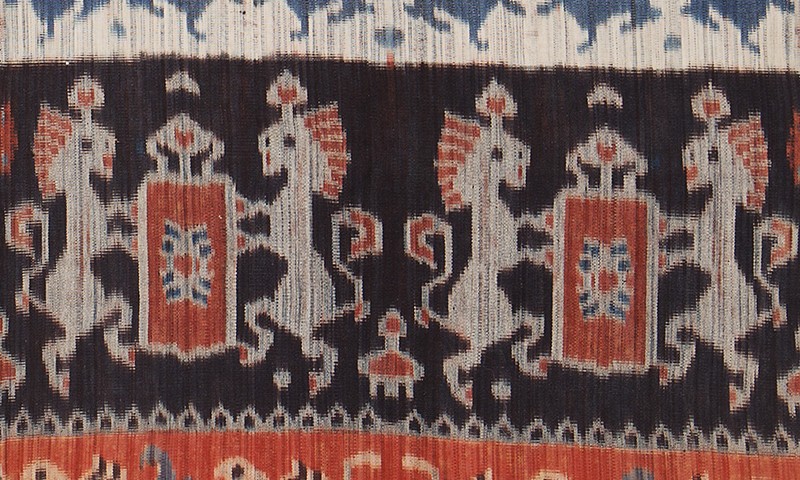 |
Shoulder Cloth (Hinggi), late 20th Century
Sumba culture; Sumba Island, East Nusa Tenggara Province, Lesser Sunda Islands, Indonesia
Cotton; 48 × 104 in.
2016.15.44
Anonymous Gift |
Sumba Over the Rainbow
As mentioned above, hinggi are a fascinating synthesis of local and foreign styles. The size of Sumba and its lack of the kinds of resources colonial powers were interested in meant that it was relatively unaffected by the acculturation that many of the larger islands faced. All the same, a vibrant inter-regional trading lineage meant that the Sumbanese people encountered traders from India, China, the Netherlands, Portugal and more. And all these interactions were quite literally woven into the design of hinggi. As was the case thousands of miles away with Tongan tapa cloths, European traders and later colonial control led to heraldic imagery becoming well-incorporated into hinggi. These textiles tend to be symmetric across at least one axis which likely played a role in this ready adoption. Bowers examples seem to be variations on the royal coat of arms of the Kingdom of the Netherlands. Other foreign motifs include non-indigenous or mythological Chinese animals and Indian geometric motifs from patola textiles.
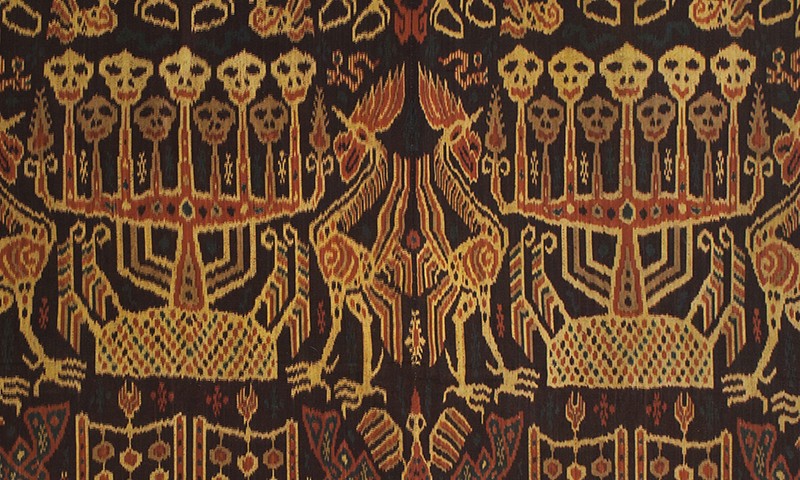 |
Shoulder Cloth (Hinggi), late 20th Century
Sumba culture; Sumba Island, East Nusa Tenggara Province, Lesser Sunda Islands, Indonesia
Cotton; 43 × 116 in.
2016.15.46
Anonymous Gift |
One Step Ahead
Of course, the other side of this design synthesis are motifs which come directly from the Sumbanese people. Several motifs are worth noting, but perhaps the most popular motif—certainly the most frequently examined by scholars—is the skull tree. This motif symbolizes power and hails back to a time before Dutch colonial oversight when the Sumbanese people participated in headhunting. Even more contemporary hinggi utilize this motif in their designs as we can see in multiple Bowers examples. Human figures representing ancestors and several endemic animals such as roosters and horses also serve as common enough motifs for these textiles. The bundling dying process of ikat leads to the overall impression that the shapes and figures of hinggi are pleasantly blurred. With hinggi though, it is more than just the lines that are blended. The beautiful, colorful aesthetics of these cloths are the result of many cultures’ designs being brought together by Indonesian weavers.
Text and images may be under copyright. Please contact Collection Department for permission to use. References are available on request. Information subject to change upon further research.






Comments